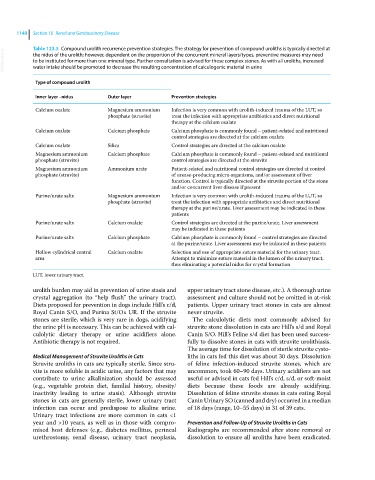Page 1202 - Clinical Small Animal Internal Medicine
P. 1202
1140 Section 10 Renal and Genitourinary Disease
VetBooks.ir Table 123.3 Compound urolith recurrence prevention strategies. The strategy for prevention of compound uroliths is typically directed at
the nidus of the urolith; however, dependent on the proportion of the concurrent mineral layers/types, preventive measures may need
to be instituted for more than one mineral type. Further consultation is advised for these complex stones. As with all uroliths, increased
water intake should be promoted to decrease the resulting concentration of calculogenic material in urine
Type of compound urolith
Inner layer –nidus Outer layer Prevention strategies
Calcium oxalate Magnesium ammonium Infection is very common with urolith‐induced trauma of the LUT, so
phosphate (struvite) treat the infection with appropriate antibiotics and direct nutritional
therapy at the calcium oxalate
Calcium oxalate Calcium phosphate Calcium phosphate is commonly found – patient‐related and nutritional
control strategies are directed at the calcium oxalate
Calcium oxalate Silica Control strategies are directed at the calcium oxalate
Magnesium ammonium Calcium phosphate Calcium phosphate is commonly found – patient‐related and nutritional
phosphate (struvite) control strategies are directed at the struvite
Magnesium ammonium Ammonium urate Patient‐related and nutritional control strategies are directed at control
phosphate (struvite) of urease‐producing micro organisms, and/or assessment of liver
function. Control is typically directed at the struvite portion of the stone
and/or concurrent liver disease if present
Purine/urate salts Magnesium ammonium Infection is very common with urolith‐induced trauma of the LUT, so
phosphate (struvite) treat the infection with appropriate antibiotics and direct nutritional
therapy at the purine/urate. Liver assessment may be indicated in these
patients
Purine/urate salts Calcium oxalate Control strategies are directed at the purine/urate. Liver assessment
may be indicated in these patients
Purine/urate salts Calcium phosphate Calcium phosphate is commonly found – control strategies are directed
at the purine/urate. Liver assessment may be indicated in these patients
Hollow cylindrical central Calcium oxalate Selection and use of appropriate suture material for the urinary tract.
area Attempt to minimize suture material in the lumen of the urinary tract,
thus eliminating a potential nidus for crystal formation
LUT, lower urinary tract.
urolith burden may aid in prevention of urine stasis and upper urinary tract stone disease, etc.). A thorough urine
crystal aggregation (to “help flush” the urinary tract). assessment and culture should not be omitted in at‐risk
Diets proposed for prevention in dogs include Hill’s c/d, patients. Upper urinary tract stones in cats are almost
Royal Canin S/O, and Purina St/Ox UR. If the struvite never struvite.
stones are sterile, which is very rare in dogs, acidifying The calculolytic diets most commonly advised for
the urine pH is necessary. This can be achieved with cal struvite stone dissolution in cats are Hill’s s/d and Royal
culolytic dietary therapy or urine acidifiers alone. Canin S/O. Hill’s Feline s/d diet has been used success
Antibiotic therapy is not required. fully to dissolve stones in cats with struvite urolithiasis.
The average time for dissolution of sterile struvite cysto
Medical Management of Struvite Uroliths in Cats liths in cats fed this diet was about 30 days. Dissolution
Struvite uroliths in cats are typically sterile. Since stru of feline infection‐induced struvite stones, which are
vite is more soluble in acidic urine, any factors that may uncommon, took 60–90 days. Urinary acidifiers are not
contribute to urine alkalinization should be assessed useful or advised in cats fed Hill’s c/d, s/d, or soft‐moist
(e.g., vegetable protein diet, familial history, obesity/ diets because these foods are already acidifying.
inactivity leading to urine stasis). Although struvite Dissolution of feline struvite stones in cats eating Royal
stones in cats are generally sterile, lower urinary tract Canin Urinary SO (canned and dry) occurred in a median
infection can occur and predispose to alkaline urine. of 18 days (range, 10–55 days) in 31 of 39 cats.
Urinary tract infections are more common in cats <1
year and >10 years, as well as in those with compro Prevention and Follow‐Up of Struvite Uroliths in Cats
mised host defenses (e.g., diabetes mellitus, perineal Radiographs are recommended after stone removal or
urethrostomy, renal disease, urinary tract neoplasia, dissolution to ensure all uroliths have been eradicated.

